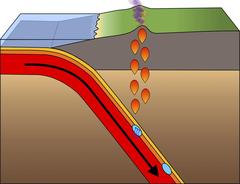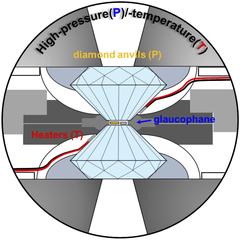URL: https://www.desy.de/news/news_search/index_eng.html
Breadcrumb Navigation
DESY News: Minerals let Earth's oceans seep down deeper than expected
News
News from the DESY research centre
Minerals let Earth's oceans seep down deeper than expected
A bigger volume of the world's oceans is seeping deeper into Earth's mantle than expected: That is the result of a study investigating a water-bearing mineral abundant in the oceanic crust. High-pressure experiments at DESY's X-ray source PETRA III show that the mineral glaucophane is surprisingly stable up to 240 kilometres underground, which means it also carries water down to this depth. Scientists attribute this to the gradual cooling of Earth's interior over geological timescales. The cooler temperatures let glaucophane and possibly other water-bearing minerals survive to greater pressures, as the team headed by Yongjae Lee from Yonsei University in South Korea reports in the journal Nature Communications. The scientists estimate that in about 200 million years, an additional volume equal to the Arctic Ocean could seep deep into Earth's mantle this way.

Along the subduction zones, slabs are diving into Earth's mantle and can carry substantial amounts of water downward via water-bearing minerals. Credit: Yonsei University, Yoonah Bang/Yongjae Lee (after Plank & Manning (2019))
However, Earth's interior is slowly cooling by about 50 to 100 degrees Celsius per one billion years, and this cooling is getting faster. As a consequence, “cold” subduction zones have developed in many places on the globe in recent geological history. The temperatures in these zones are still sizzling hot compared to everyday standards, but significantly cooler than in “warm” subduction zones, as well as cooler than in the geologic past. “Using high-pressure high-temperature equipment, we have simulated today's conditions in cold subduction zones in the lab and studied the behaviour of glaucophane under these conditions,” explains co-author Hanns-Peter Liermann, head of the Extreme Conditions Beamline P02.2 at DESY's X-ray source PETRA III. “To our surprise, glaucophane remains stable at conditions corresponding to much greater depths of up to 240 kilometres in cold subduction zones.”

In the high-pressure cell, glaucophane samples are heated and squeezed between two diamond anvils. Credit: Yonsei University, Yoonah Bang/Huijeong Hwang/Yongjae Lee
The investigation has also other implications for the evolution of Earth: Since underground water in the shallower depths is a major driver for volcanism and earthquakes, these phenomena are getting less frequent on geological timescales, as Lee points out. “As Earth continuous to cool down, the transport of water to its interior is expected to be extended to greater depths, thereby suppressing earthquakes and volcanism.”
Scientists from Yonsei University and Seoul National University in South Korea, Lawrence Livermore National Laboratory, Argonne National Laboratory and University of Chicago in the U.S., the Center for High Pressure Science & Technology Advanced Research in China, Ehime University in Japan and DESY have contributed to this research. The study is part of the Early Science Program of the Centre for Molecular Water Science (CMWS) that is currently being set up at DESY, and associated to a long-term project of Yongjae Lee at the Extreme Conditions Beamline P02.2 at PETRA III.
Reference:
The stability of subducted glaucophane with the Earth’s secular cooling; Yoonah Bang, Huijeong Hwang, Taehyun Kim, Hyunchae Cynn, Yong Park, Haemyeong Jung, Changyong Park, Dmitry Popov, Vitali B. Prakapenka, Lin Wang, Hanns-Peter Liermann, Tetsuo Irifune, Ho-Kwang Mao and Yongjae Lee; Nature Communications, 2021; DOI: 10.1038/s41467-021-21746-8




